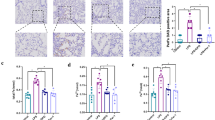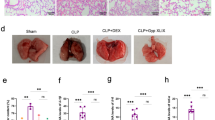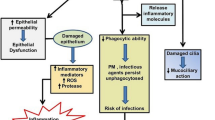Abstract
Background
The potential protective properties of carvacrol (CRV), which possesses various biological and pharmacological properties, against lung toxicity caused by cadmium (Cd), a major environmental pollutant, were investigated in the present study.
Methods and results
In the study, rats were given 25 or 50 mg/kg CRV orally 30 min after administrating 25 mg/kg cadmium chloride for seven days. Subsequently, the levels of 8-OHdG, MMP-2, and MMP-9, as well as markers of oxidative stress, inflammation, and apoptosis, were analyzed in the lung tissue of the animals. The results revealed that CRV exhibited antioxidant characteristics and raised SOD, CAT, GPx, and CAT levels and decreased the MDA levels induced by Cd. It also suppressed proinflammatory cytokines by lowering the levels of CRV NF-κB and p38 MAPK, thus exerting an anti-inflammatory effect against Cd. It was found that the levels of Bax, Caspase-3, and cytochrome c increased by Cd were decreased by the application of CRV. CRV also showed an anti-apoptotic effect by increasing Bcl-2 levels. The levels of 8-OHdG, MMP2, and MMP9, which increased with Cd administration, were observed to reduce after treatment with CRV.
Conclusions
The results indicate that CRV has protective properties against Cd-induced lung toxicity.







Similar content being viewed by others
Data availability
Not applicable.
Code availability
Not applicable.
References
El-Sokkary GH, Nafady AA, Shabash EH (2010) Melatonin administration ameliorates cadmium-induced oxidative stress and morphological changes in the liver of rat. Ecotoxicol Environ Saf 73:456–463
Caglayan C, Taslimi P, Türk C, Gulcin İ, Kandemir FM, Demir Y et al (2020) Inhibition effects of some pesticides and heavy metals on carbonic anhydrase enzyme activity purified from horse mackerel (Trachurus trachurus) gill tissues. Environ Sci Pollut Res 27:1–10
Caglayan C, Taslimi P, Türk C, Kandemir FM, Demir Y, Gulcin I (2019) Purification and characterization of the carbonic anhydrase enzyme from horse mackerel (Trachurus trachurus) muscle and the impact of some metal ions and pesticides on enzyme activity. Comp Biochem Physiol C Toxicol Pharmacol 226:108605
Demenesku J, Aleksandrov AP, Mirkov I, Ninkov M, Zolotarevski L, Kataranovski D et al (2016) Strain differences of cadmium-induced toxicity in rats: Insight from spleen and lung immune responses. Toxicol Lett 256:33–43
Ognjanović BI, Marković SD, Ðorđević NZ, Trbojević IS, Štajn AŠ, Saičić ZS (2010) Cadmium-induced lipid peroxidation and changes in antioxidant defense system in the rat testes: Protective role of coenzyme Q10 and Vitamin E. Reprod Toxicol 29:191–197
Wang Y, Wu Y, Luo K, Liu Y, Zhou M, Yan S et al (2013) The protective effects of selenium on cadmium-induced oxidative stress and apoptosis via mitochondria pathway in mice kidney. Food Chem Toxicol 58:61–67
Özaslan MS, Demir Y, Küfrevioğlu OI, Çiftci M (2017) Some metals inhibit the glutathione S-transferase from Van Lake fish gills. J Biochem Mol Toxic 31:e21967
Renugadevi J, Prabu SM (2010) Cadmium-induced hepatotoxicity in rats and the protective effect of naringenin. Exp Toxicol Pathol 62:171–181
Wu KC, Liu JJ, Klaassen CD (2012) Nrf2 activation prevents cadmium-induced acute liver injury. Toxicol Appl Pharmacol 263:14–20
Caglayan C, Kandemir FM, Yildirim S, Kucukler S, Eser G (2019) Rutin protects mercuric chloride-induced nephrotoxicity via targeting of aquaporin 1 level, oxidative stress, apoptosis and inflammation in rats. J Trace Elem Med Biol 54:69–78
Ileriturk M, Benzer F, Aksu EH, Yildirim S, Kandemir FM, Dogan T et al (2021) Chrysin protects against testicular toxicity caused by lead acetate in rats with its antioxidant, anti-inflammatory, and antiapoptotic properties. J Food Biochem 45:e13593
Manouchehrabadi M, Farhadi M, Azizi Z, Torkaman-Boutorabi A (2020) Carvacrol protects against 6-hydroxydopamine-induced neurotoxicity in in vivo and in vitro models of Parkinson’s disease. Neurotox Res 37:156–170
Şen HS, Şen V, Bozkurt M, Türkçü G, Güzel A, Sezgi C et al (2014) Carvacrol and pomegranate extract in treating methotrexate-induced lung oxidative injury in rats. Med Sci Monit 20:1983
Noshy PA, Elhady MA, Khalaf AAA, Kamel MM, Hassanen EI (2018) Ameliorative effect of carvacrol against propiconazole-induced neurobehavioral toxicity in rats. Neurotoxicology 67:141–149
Bravo D, Pirgozliev V, Rose S (2014) A mixture of carvacrol, cinnamaldehyde, and capsicum oleoresin improves energy utilization and growth performance of broiler chickens fed maize-based diet. J Anim Sci 92:1531–1536
Banik S, Akter M, Bondad SEC, Saito T, Hosokawa T, Kurasaki M (2019) Carvacrol inhibits cadmium toxicity through combating against caspase dependent/independent apoptosis in PC12 cells. Food Chem Toxicol 134:110835
Garber JC, Wayne Barbee R, Bielitzki JT, Clayton LA, Donovan JC, Hendriksen CF et al (2011) Committee for the update of the guide for the care and use of laboratory animals. Guide for the care and use of laboratory animals, 8th edn. National Academy of Sciences, Washington DC, USA
Barnwal P, Vafa A, Afzal S, Shahid A, Hasan S, Alpashree, et al (2018) Benzo (a) pyrene induces lung toxicity and inflammation in mice: Prevention by carvacrol. Hum Exp Toxicol 37:752–61
Kim KS, Lim H-J, Lim JS, Son JY, Lee J, Lee BM et al (2018) Curcumin ameliorates cadmium-induced nephrotoxicity in Sprague-Dawley rats. Food Chem Toxicol 114:34–40
Placer ZA, Cushman LL, Johnson BC (1966) Estimation of product of lipid peroxidation (malonyl dialdehyde) in biochemical systems. Anal Biochem 16:359–364
Sun Y, Oberley LW, Li Y (1988) A simple method for clinical assay of superoxide dismutase. Clin Chem 34:497–500
Aebi H (1984) [13] Catalase in vitro. Methods Enzymol 105:121–126
Lawrence RA, Burk RF (1976) Glutathione peroxidase activity in selenium-deficient rat liver. Biochem Biophys Res Commun 71:952–958
Sedlak J, Lindsay RH (1968) Estimation of total, protein-bound, and nonprotein sulfhydryl groups in tissue with Ellman’s reagent. Anal Biochem 25:192–205
Lowry OH, Rosebrough NJ, Farr AL, Randall RJ (1951) Protein measurement with the Folin phenol reagent. J Biol Chem 193:265–275
Livak KJ, Schmittgen TD (2001) Analysis of relative gene expression data using real-time quantitative PCR and the 2− ΔΔCT method. Methods 25:402–8
Salama SA, Arab HH, Hassan MH, Maghrabi IA (2019) Cadmium-induced hepatocellular injury: modulatory effects of γ-glutamyl cysteine on the biomarkers of inflammation, DNA damage, and apoptotic cell death. J Trace Elem Med Biol 52:74–82
Yu W, Xu Z, Gao Q, Xu Y, Wang B, Dai Y (2020) Protective role of wogonin against cadmium induced testicular toxicity: Involvement of antioxidant, anti-inflammatory and anti-apoptotic pathways. Life Sci 258:118192
Aksu EH, Kandemir FM, Altun S, Küçükler S, Çomaklı S, Ömür AD (2016) Ameliorative effect of carvacrol on cisplatin-Induced reproductive damage in male rats. J Biochem Mol Toxicol 30:513–520
Miltonprabu S, Manoharan V (2016) Hepatoprotective effect of grape seed proanthocyanidins on Cadmium-induced hepatic injury in rats: possible involvement of mitochondrial dysfunction, inflammation and apoptosis. Toxicol Rep 3:63–77
Radwan OK, Alzahrani YA, Kassab RB (2018) Neuroprotective efficiency of Mangifera indica leaves extract on cadmium-induced cortical damage in rats. Metab Brain Dis 33:1121–1130
Gur C, Kandemir FM, Darendelioglu E, Caglayan C, Kucukler S, Kandemir O et al (2021) Morin protects against acrylamide-induced neurotoxicity in rats: an investigation into different signal pathways. Environ Sci Pollut Res 28:1–12
Celik H, Kucukler S, Ozdemir S, Comakli S, Gur C, Kandemir FM et al (2020) Lycopene protects against central and peripheral neuropathy by inhibiting oxaliplatin-induced ATF-6 pathway, apoptosis, inflammation and oxidative stress in brains and sciatic tissues of rats. Neurotoxicology 80:29–40
Refaie MM, El-Hussieny M, Zenhom NM (2018) Protective role of nebivolol in cadmium-induced hepatotoxicity via downregulation of oxidative stress, apoptosis and inflammatory pathways. Environ Toxicol Pharmacol 58:212–219
Park JH, Lee BM, Kim HS (2021) Potential protective roles of curcumin against cadmium-induced toxicity and oxidative stress. J Toxicol Environ Health B 24:95–118
Wang J, Zhu H, Wang K, Yang Z, Liu Z (2020) Protective effect of quercetin on rat testes against cadmium toxicity by alleviating oxidative stress and autophagy. Environ Sci Pollut Res 27:25278–25286
Demir Y (2020) Naphthoquinones, benzoquinones, and anthraquinones: Molecular docking, ADME and inhibition studies on human serum paraoxonase-1 associated with cardiovascular diseases. Drug Dev Res 81:628–636
Çağlayan C, Taslimi P, Demir Y, Küçükler S, Kandemir FM, Gulcin I (2019) The effects of zingerone against vancomycin-induced lung, liver, kidney and testis toxicity in rats: The behavior of some metabolic enzymes. J Biochem Mol Toxicol 33:e22381
Gabr SA, Alghadir AH, Ghoniem GA (2019) Biological activities of ginger against cadmium-induced renal toxicity. Saudi J Biol Sci 26:382–389
Chen S, Liu G, Long M, Zou H, Cui H (2018) Alpha lipoic acid attenuates cadmium-induced nephrotoxicity via the mitochondrial apoptotic pathways in rat. J Inorg Biochem 184:19–26
Kandemir FM, Caglayan C, Aksu EH, Yildirim S, Kucukler S, Gur C et al (2020) Protective effect of rutin on mercuric chloride-induced reproductive damage in male rats. Andrologia. 52:e13524
Toygar M, Aydin I, Agilli M, Aydin F, Oztosun M, Gul H et al (2015) The relation between oxidative stress, inflammation, and neopterin in the paraquat-induced lung toxicity. Hum Exp Toxicol 34:198–204
Caglayan C, Kandemir FM, Darendelioğlu E, Yıldırım S, Kucukler S, Dortbudak MB (2019) Rutin ameliorates mercuric chloride-induced hepatotoxicity in rats via interfering with oxidative stress, inflammation and apoptosis. J Trace Elem Med Biol 56:60–68
Yardim A, Kandemir FM, Ozdemir S, Kucukler S, Comakli S, Gur C et al (2020) Quercetin provides protection against the peripheral nerve damage caused by vincristine in rats by suppressing caspase 3, NF-κB, ATF-6 pathways and activating Nrf2, Akt pathways. Neurotoxicology 81:137–146
Kandemir FM, Kucukler S, Caglayan C, Gur C, Batil AA, Gülçin İ (2017) Therapeutic effects of silymarin and naringin on methotrexate-induced nephrotoxicity in rats: Biochemical evaluation of anti-inflammatory, antiapoptotic, and antiautophagic properties. J Food Biochem 41:e12398
Jiao D, Jiang Q, Liu Y, Ji L (2019) Nephroprotective effect of wogonin against cadmium-induced nephrotoxicity via inhibition of oxidative stress–induced MAPK and NF-kB pathway in Sprague Dawley rats. Hum Exp Toxicol 38:1082–1091
Rani A, Kumar A, Lal A, Pant M (2014) Cellular mechanisms of cadmium-induced toxicity: a review. Int J Environ Health Res 24:378–399
Aja PM, Izekwe FI, Famurewa AC, Ekpono EU, Nwite FE, Igwenyi IO et al (2020) Hesperidin protects against cadmium-induced pancreatitis by modulating insulin secretion, redox imbalance and iNOS/NF-ĸB signaling in rats. Life Sci 259:118268
Ansari MA, Raish M, Ahmad A, Alkharfy KM, Ahmad SF, Attia SM et al (2017) Sinapic acid ameliorate cadmium-induced nephrotoxicity: In vivo possible involvement of oxidative stress, apoptosis, and inflammation via NF-κB downregulation. Environ Toxicol Pharmacol 51:100–107
Kucukler S, Benzer F, Yildirim S, Gur C, Kandemir FM, Bengu AS et al (2021) Protective effects of chrysin against oxidative stress and inflammation induced by lead acetate in rat kidneys: a biochemical and histopathological approach. Biol Trace Elem Res 199:1501–1514
Al Olayan EM, Aloufi AS, AlAmri OD, Ola H, Moneim AEA (2020) Protocatechuic acid mitigates cadmium-induced neurotoxicity in rats: Role of oxidative stress, inflammation and apoptosis. Sci Total Environ 723:137969
Habib R, Wahdan SA, Gad AM, Azab SS (2019) Infliximab abrogates cadmium-induced testicular damage and spermiotoxicity via enhancement of steroidogenesis and suppression of inflammation and apoptosis mediators. Ecotoxicol Environ Saf 182:109398
Zhang W, Fievez L, Cheu E, Bureau F, Rong W, Zhang F et al (2010) Anti-inflammatory effects of formoterol and ipratropium bromide against acute cadmium-induced pulmonary inflammation in rats. Eur J Pharmacol 628:171–178
Kirschvink N, Vincke G, Fiévez L, Onclinx C, Wirth D, Belleflamme M et al (2005) Repeated cadmium nebulizations induce pulmonary MMP-2 and MMP-9 production and enphysema in rats. Toxicology 211:36–48
Sangartit W, Kukongviriyapan U, Donpunha W, Pakdeechote P, Kukongviriyapan V, Surawattanawan P et al (2014) Tetrahydrocurcumin protects against cadmium-induced hypertension, raised arterial stiffness and vascular remodeling in mice. PloS One 9:e114908
Fligiel SE, Standiford T, Fligiel HM, Tashkin D, Strieter RM, Warner RL et al (2006) Matrix metalloproteinases and matrix metalloproteinase inhibitors in acute lung injury. Hum Pathol 37:422–430
Ricou B, Nicod L, Lacraz S, Welgus HG, Suter PM, Dayer J-M (1996) Matrix metalloproteinases and TIMP in acute respiratory distress syndrome. Am J Respir Crit Care Med 154:346–352
Funding
No funding was received for conducting this study.
Author information
Authors and Affiliations
Contributions
KY: Conceptualization, Methodology, Formal analysis, Investigation CG: Writing-Review & Editing, Data Curation, Methodology MI: Data Curation, Methodology, Conceptualization FMK: Data Curation, Methodology, Writing—Original Draft.
Corresponding author
Ethics declarations
Conflict of interest
The authors have no conflict of interest.
Ethical approval
Ethics committee approval of the study was obtained from Atatürk University Experimental Animals Local Ethics Committee (Approval No. 2018/12/217).
Consent to participate
Not applicable.
Consent for publication
The author gives her consent for the publication of this manuscript.
Additional information
Publisher's Note
Springer Nature remains neutral with regard to jurisdictional claims in published maps and institutional affiliations.
Rights and permissions
About this article
Cite this article
Yesildag, K., Gur, C., Ileriturk, M. et al. Evaluation of oxidative stress, inflammation, apoptosis, oxidative DNA damage and metalloproteinases in the lungs of rats treated with cadmium and carvacrol. Mol Biol Rep 49, 1201–1211 (2022). https://doi.org/10.1007/s11033-021-06948-z
Received:
Accepted:
Published:
Issue Date:
DOI: https://doi.org/10.1007/s11033-021-06948-z




